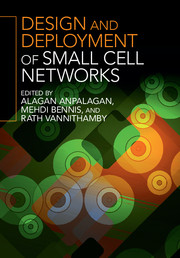Book contents
- Frontmatter
- Contents
- List of contributors
- Preface
- 1 Mobility performance optimization for 3GPP LTE HetNets
- 2 Design and performance analysis of multi-radio small cell networks
- 3 Dynamic TDD small cell management
- 4 3GPP RAN standards for small cells
- 5 Dense networks of small cells
- 6 Traffic offloading scenarios for heterogeneous networks
- 7 Required number of small cell access points in heterogeneous wireless networks
- 8 Small cell deployments: system scenarios, performance, and analysis
- 9 Temporary cognitive small cell networks for rapid and emergency deployments
- 10 Long-term evolution (LTE) and LTE-Advanced activities in small cell networks
- 11 Game theory and learning techniques for self-organization in small cell networks
- 12 Energy efficient strategies with BS sleep mode in green small cell networks
- 13 Mobility management in small cell heterogeneous networks
- 14 The art of deploying small cells: field trial experiments, system design, performance prediction, and deployment feasibility
- 15 Centralized self-optimization of interference management in LTE-A HetNets
- 16 Self-organized ICIC for SCN
- 17 Large-scale deployment and scalability
- 18 Energy efficient heterogeneous networks
- 19 Time- and frequency-domain e-ICIC with single- and multi-flow carrier aggregation in HetNets
- Index
- References
16 - Self-organized ICIC for SCN
Published online by Cambridge University Press: 05 December 2015
- Frontmatter
- Contents
- List of contributors
- Preface
- 1 Mobility performance optimization for 3GPP LTE HetNets
- 2 Design and performance analysis of multi-radio small cell networks
- 3 Dynamic TDD small cell management
- 4 3GPP RAN standards for small cells
- 5 Dense networks of small cells
- 6 Traffic offloading scenarios for heterogeneous networks
- 7 Required number of small cell access points in heterogeneous wireless networks
- 8 Small cell deployments: system scenarios, performance, and analysis
- 9 Temporary cognitive small cell networks for rapid and emergency deployments
- 10 Long-term evolution (LTE) and LTE-Advanced activities in small cell networks
- 11 Game theory and learning techniques for self-organization in small cell networks
- 12 Energy efficient strategies with BS sleep mode in green small cell networks
- 13 Mobility management in small cell heterogeneous networks
- 14 The art of deploying small cells: field trial experiments, system design, performance prediction, and deployment feasibility
- 15 Centralized self-optimization of interference management in LTE-A HetNets
- 16 Self-organized ICIC for SCN
- 17 Large-scale deployment and scalability
- 18 Energy efficient heterogeneous networks
- 19 Time- and frequency-domain e-ICIC with single- and multi-flow carrier aggregation in HetNets
- Index
- References
Summary
In recent years the use of data services in mobile networks has notably increased, which requires a higher quality of services and data throughput capacity from operators. These requirements become much more demanding in indoor environments, where, due to the wall-penetration losses, communications suffer a higher detriment. As a solution, short-range base stations (BSs), known as femto cells [1], are proposed. Femto cells are installed by the end consumer and communicate with the macro cell system through the internet by means of a digital subscriber line (DSL), fiber, or cable connection. Due to this deployment model, the number and location of femto cells are unknown for the operators and therefore there is no possibility for centralized network planning. In the case of co-channel operation, which is the more rewarding option for operators in terms of spectral efficiency, an aggregated interference problem may arise due to multiple, simultaneous, and uncoordinated femto cell transmissions. On the other hand, the macro cell network can also cause significant interference to the femto cell system due to a lack of control of position of the femto nodes and their users. In this chapter we focus then on the challenging problem in the area of small cell networks, the inter-cell interference coordination among different layers of the network.
We propose two different self-organizing solutions, based on two smart techniques that operate on the most appropriate configuration parameters of the network for each situation. In particular, we address femto–macro and macro–femto problems. On the one hand, for the femto–macro case, we propose in Section 16.1 a machine learning (ML) approach to optimize the transmission power levels by modeling the multiple femto BSs as a multi-agent system [2], where each femto cell is able to learn transmission power policy in such a way that the interference it is generating, added to the whole femto cell network interference, does not jeopardize the macro cell system performance. To do this, we propose a reinforcement learning (RL) category of solutions [3], known as time-difference learning. On the other hand, for the macro–femto problem, we propose in Section 16.2 a solution based on interference minimization through self-organization of antenna parameters. In homogeneous macro cell networks, BS antenna parameters are configured in the planning and deployment phase and left unchanged for a long time.
- Type
- Chapter
- Information
- Design and Deployment of Small Cell Networks , pp. 393 - 424Publisher: Cambridge University PressPrint publication year: 2015



